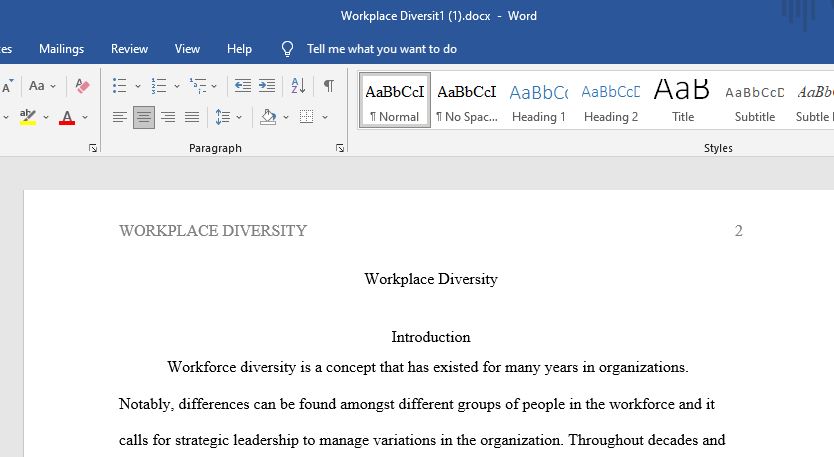Management Ethics- Workplace Diversity
- Choose a research topic from the chapter readings or from the list provided by your professor.
- Research/find a minimum at least five (5) or more, different peer-reviewed articles on your topic. The article(s) must be relevant and from a peer-reviewed source. While you may use relevant articles from any time frame, current/published within the last five (5) years are preferred. Using literature that is irrelevant or unrelated to the chosen topic will result in a point reduction.
- Write a ten 10-15 pages double spaced paper in APA format discussing the findings on your specific topic in your own words. Note – paper length does not include cover page, abstract, or references page(s).
- Structure your paper as follows:
- Cover page
- Overview describing the importance of the research topic to current business and professional practice in your own words.
- Purpose of Research should reflect the potential benefit of the topic to the current business and professional practice and the larger body of research.
- Review of the Literature summarized in your own words. Note that this should not be a “copy and paste” of literature content, nor should this section be substantially filled with direct quotes from the article. A literature review is a summary of the major points and findings of each of the selected articles (with appropriate citations). Direct quotations should be used sparingly. Normally, this will be the largest section of your paper (this is not a requirement; just a general observation).
- Practical Application of the literature. Describe how your findings from the relevant research literature can shape, inform, and improve current business and professional practice related to your chosen topic.
- Conclusion in your own words
- References formatted according to APA style requirements
Topics
- General systems theory
- Stakeholder theory of the firm
- Issue management process
- Stakeholder materiality
- Performance-expectation gap
- B corporation
- Social ventures
- Corporate citizenship
- Foreign direct investments (FDIs)
- International financial and trade institutions (IFTIs)
- Nongovernmental organizations (NGOs)
- Sarbanes-Oxley Act
- U.S. Corporate Sentencing Guidelines
- Utilitarian reasoning
- U.S. Foreign Corrupt Practices Act
- Employee ethics training
- Ethics and compliance officer (ECO)
- Dodd-Frank Act
- Negative externalities
- Market failures
- Super PACs
- The Business Roundtable
- Dark money
- Convention on Climate Change
- Industrial ecology
- Paris Agreement
- Chief sustainability officer (CSO)
- Superfund (CERCLA)
- Ecologically sustainable organization (ESO)
- m-commerce
- Bitcoin
- Phishing
- Digital Millennium Copyright Act
- General Data Protection Regulation (GDPR)
- Right to be forgotten
- Say-on-pay
- Shareholder resolutions
- Insider trading
- Alternative dispute resolution
- Behavioral advertising
- Strict liability
- Employee assistance programs (EAPs)
- Occupational Safety and Health Administrations (OSHA)
- Living wage
- Equal Employment Opportunity Commission (EEOC)
- Workforce diversity
- Occupational segregation
- Supply chain audit
- Integrated supplier scorecard
- Community relations manager
- Skills-based volunteerism
- License to operate
- Crisis management
- User-generated content
- Corporate identity
Answer preview:

word limit:3070
